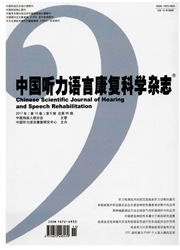

 中文摘要:
中文摘要:
目的验证自适应噪声下旬子识别阈测试方法的可靠性,获得自适应噪声下语句识别阈算法的正常青年男性参考值。方法21名正常听力男性青年(平均年龄21±1.56岁)接受测试。采用嘈杂语噪声下汉语短旬识别测听材料,使用自行编制的自适应算法经言语测昕软件进行噪声下旬子识别阈测试。受试者每人每耳各测试2表。使用维验将获得的平均识别阈SNR‰与所采用材料的整体识别阈SNR50进行比较。结果自适应方法测得噪声下平均句子识别阈SNR50a为(-5.75±0.92)dB。左右耳识别阈之间无统计学差异(P=0.0796)。正常青年男性95%医学参考值范围为(-7.55dB,-3.95dB)。使用自适应算法获得的噪声下旬子识别阈略高于正常听力人群中通过多强度测试获得的识别阈(P〈0.0001)。结论该自适应噪声下语句识别阈算法快速、可靠,为临床提供了一种评价噪声下言语识别能力的测听方法。
 英文摘要:
英文摘要:
Objective To verify the reliability of adaptive algorithm for sentence recognition threshold test in babble noise and to obtain the norms of normal-hearing young men of sentence recognition threshold using this algorithm, Methods Twenty-one normal-hearing young men (mean age 21 ± 1.56 years) were included in this study. The sentence recognition thresholds in babble noise were tested with a set of sentence recognition materials using self-adaptive algorithm via audiometry software. Both ears of the subjects were tested by 2 sentence lists respectively. The u test was used to compare the mean adaptive recognition threshold (SNR50a) and the overall threshold of previous research (SNR50). Results The mean adaptive sentence recognition threshold (SNR50a) was (-5.75 ± 0.92) dB. There was no significant difference between the left ears and right ears in SNR50a (P= 0.0796). The 95% reference range of normal-hearing young men was(-7.55 dB,-3.95 dB). The SNR50a was slightly higher than SNR50 (P〈0.0001). Conclusion The adaptive algorithm for sentence recognition threshold in noise was fast and reliable for clinical practice to evaluate the ability of speech recognition in noise.
 同期刊论文项目
同期刊论文项目
 同项目期刊论文
同项目期刊论文
 期刊信息
期刊信息
